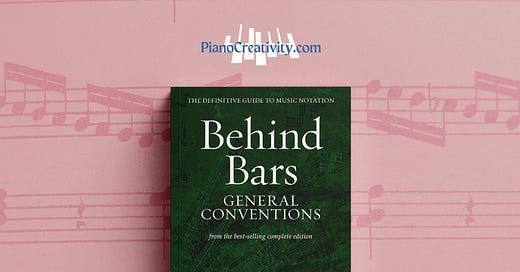Review: Behind Bars: General Conventions
This is a fantastic resource that should be on the bookshelves of everyone who writes music
Anyone who’s tried to teach poorly engraved music knows that it can be a challenge.
It’s easy to understand why when you consider this poorly formatted text:
it”s rEallY dIfficult 2. rEad tXt th@ doesn,t f0ll0w. f0rmattIng c0nventi0ns!
When I first started writing music I often had formatting questions and my research repeatedly pointed me towards a book sometimes described as “the Bible of music engraving”, Elaine Gould’s Behind Bars: The Definitive Guide to Musical Notation. The general consensus was that this was an essential book that had all the answers and set the standard for quality engraving.
I didn’t buy it, though I often considered it. At £80 it is a significant outlay. Instead I found a cheaper, older alternative, which has served me reasonably well, but I have often wondered if I made the wrong choice.
Happily, Faber Music have now released a concise edition, Behind Bars: General Conventions.

Essential reading
Behind Bars: General Conventions is a fantastic resource that should be on the shelves of anyone who writes music.
The complete version of Behind Bars contains three lengthy sections:
General Conventions, which covers all the basics
Idiomatic Notation, which explores the engraving quirks of different instruments
Layout and Presentation
The new book, Behind Bars: General Conventions, contains just the first section. Over the course of 256 pages it covers:
Ground Rules
Chords — Dotted Notes — Ties
Accidentals and Key Signatures
Dynamics and Articulation
Grace Notes, Arpeggiated Chords, Trills, Glissandos and Vibrato
Metre
Tuplets
Repeat Signs
Clarity
It’s exactly the kind of writing I love: clear, concise, and unpretentious. Gould has a gift for explaining complex concepts briefly and logically. There is inevitably a great deal of technical language, but it is never used in a pretentious way; the grammar and sentence structure is remarkably lucid throughout.
The formatting of the text is unsurprisingly excellent. The use of different headings makes it simple to quickly find what you’re looking for amidst a wealth of detail. When used with the excellent index, it’s a relatively trivial task to find the one paragraph you need amidst the wealth of detail.
There are many examples but never an excessive amount. Typically there is an example of how to do it correctly next to an incorrect example. Occasionally Gould gives a couple of correct options.
Doesn’t engraving software make this book redundant?
The short answer is: no.
The longer answer is this: while engraving software does automate many of the engraving decisions that this book explains, all software makes questionable decisions. We’ve no doubt all experienced moments where we’re playing through our score, and it looks frustratingly unclear. Sometimes the computer simply makes a wrong decision that makes something difficult to decode, and it takes a human eye to spot it. Moreover, sometimes the computer simply cannot make a decision for us.
A great example of this is the question of whether or not to place accidentals. There’s a fascinating section of the book discussing cautionary accidentals, i.e. accidentals that aren’t strictly necessary, but may be helpful. A computer cannot accurately predict when a human will need a cautionary accidental. Later there is another section that explains the different accidental placement systems for intensely chromatic music and, again, a computer simply cannot make the decision of which accidental placement system will make any particular piece most clear.
Simply put, this book gives you the knowledge to confidently correct your computer.
An essential purchase
Clear, concise, well-formatted, and densely packed with useful information, this book belongs on the shelves of everyone who publishes music.
It’s published by Faber Music.





